The most effective underground food storage methods combine traditional wisdom with modern engineering. You'll get the best results from a properly constructed root cellar, which maintains temperatures between 32-40°F for up to 8 months of vegetable storage. Spring-integrated systems offer superior cooling through natural water flow, while earth-sheltered clamps provide flexible storage options for smaller harvests. Ground temperature control methods, cold spring construction, and natural underground water systems round out your choices. Underground storage near natural springs gives you bonus cooling benefits, while proper drainage guarantees ideal humidity levels. Discover which method aligns with your specific climate and storage needs.
Traditional Root Cellar Design
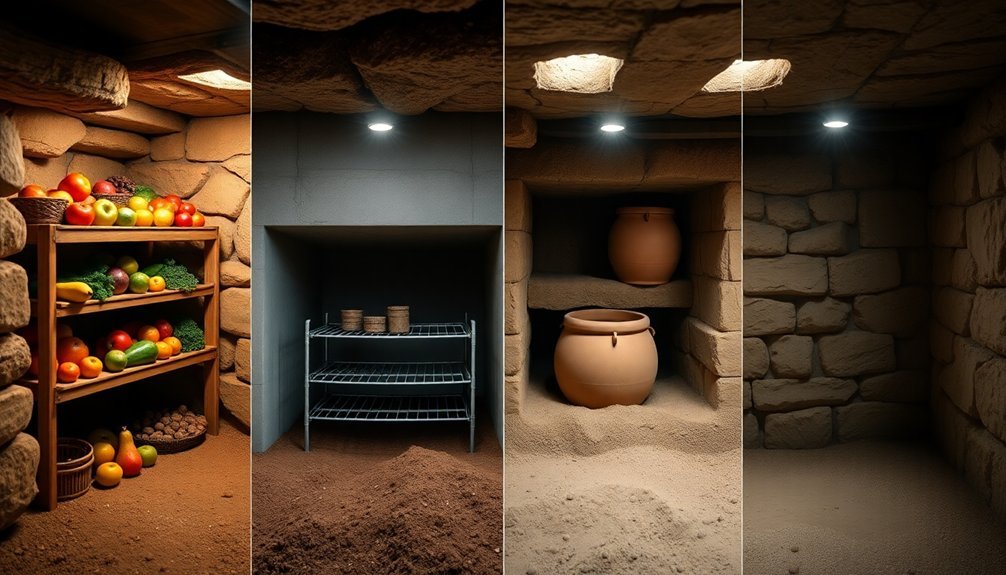
Traditional root cellars have served as reliable underground food storage spaces for centuries, utilizing natural ground temperatures and smart design principles to preserve food.
You'll find three main construction approaches: digging down and building a shed above, excavating into a hillside, or creating a ground-level structure covered with earth and rocks.
The ideal temperature range is 32 to 35 degrees Fahrenheit for storing most root vegetables and crops effectively.
When building your root cellar, you'll want to position it on the north side of your property or facing north to minimize sun exposure. The structure should incorporate heavy timber supports and a gable roof with birch bark shingles to control moisture.
You'll need a double-door entrance system to create an effective frost barrier, and proper ventilation with both intake and outlet vents.
For best performance, you'll need to place intake vents near the ground and outlet vents near the ceiling to create natural air circulation. It's crucial to seal these vents properly with packed cloth or rubber gaskets during winter.
To prevent unwanted visitors, install wire screens over vents and seal any small spaces with silicone caulk. Remember to reinforce walls and roofing adequately to prevent structural collapse.
Spring House Cooling Systems
You'll find that spring house cooling systems rely on the constant flow of spring water to maintain consistent temperatures for food storage.
The natural stone construction creates a solid, insulating structure that helps regulate the internal climate while allowing the cool spring water to circulate beneath the storage area.
The flowing water not only cools the space but also maintains ideal humidity levels, making it an efficient passive cooling system for preserving perishables. Similar to modern variable-speed operation, the gradual flow of spring water provides steady, continuous cooling rather than intermittent temperature changes.
Spring Water Flow Design
Spring house cooling systems represent one of the most effective natural cooling methods, harnessing the power of flowing spring water and underground thermal mass. You'll want to integrate underground pipes at a depth of 6-8 feet, where the earth's temperature remains stable. By combining spring water flow with buried pipes, you're creating a natural cooling system that doesn't require electricity. Similar to commercial building systems, the temperature should be maintained between 70 and 90ºF for optimal efficiency.
| Design Element | Key Benefit |
|---|---|
| Buried Pipes | Maintains 6-8 foot depth for ideal cooling |
| Coiled Layout | Maximizes cooling contact time with earth |
| Shaded Placement | Prevents unwanted soil temperature rise |
| Insulated Ducts | Preserves cooled air temperature integrity |
When designing your spring water flow system, you'll need to take into account proper pipe placement in shaded areas and implement adequate insulation to maintain consistent temperatures. The system works best when you incorporate natural ventilation through chimney effects, creating a continuous airflow cycle. You can enhance the cooling effect by installing longer, coiled pipes that extend the path of traveling air. This design not only keeps your storage space cool but also helps manage humidity levels, making it ideal for food preservation in hot and humid climates.
Natural Stone Construction
Building on the principles of spring water cooling, natural stone construction offers remarkable thermal benefits for underground food storage.
You'll find that locally sourced stone materials provide cost-effective thermal diffusion while reducing transportation expenses and environmental impact. When you're constructing your storage space, dry stacking stones can save time and labor compared to traditional building methods.
To maximize the structure's effectiveness, you'll want to dig several feet into the ground where temperatures naturally remain in the 50s Fahrenheit.
Build your stone walls up to seven feet high, guaranteeing the floor sits slightly above the outside ground level for proper drainage. You'll need to reinforce the roof with logs and add insulation using urethane or Styrofoam sheets before covering with earth.
Don't forget to incorporate ventilation by leaving gaps for vent pipes, and include gravel for drainage.
When designing your storage shelves, space them with gaps to promote air circulation. The combination of stone walls and surrounding soil will help maintain stable temperatures year-round, while proper waterproofing guarantees your structure's longevity.
Regular maintenance of the backfill around your cellar will prevent settling issues.
Natural Underground Water Storage
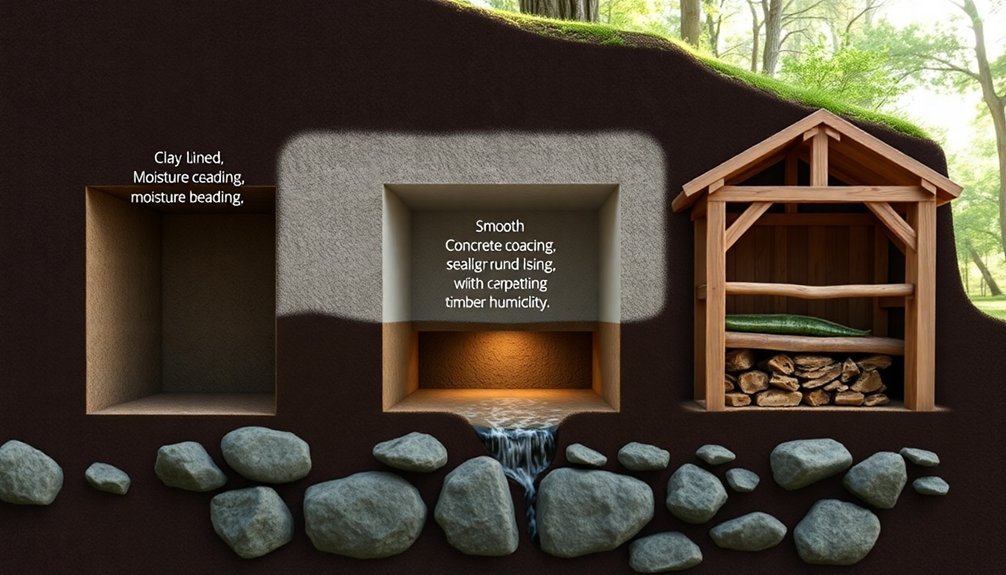
You'll find efficient water collection systems beneath your food storage area by implementing recharge basins filled with sand, gravel, or other natural filtration materials.
Your underground water storage can connect directly to natural springs when they're present, creating a sustainable year-round supply for your storage needs.
When properly designed, these systems protect your water from external contamination while maintaining consistent temperatures through natural soil insulation.
Water Collection Systems Below
Beneath the Earth's surface lies one of nature's most efficient water storage solutions: underground water collection systems.
You'll find these systems utilize both natural aquifers and engineered infiltration methods to store and protect freshwater resources.
You can collect water through various surface methods, including rooftop catchments, ponds, and artificial streams.
Once collected, the water's directed into the ground through infiltration basins or vertical wells, depending on your soil conditions.
If you're working with a confined aquifer, you'll need to use deep injection methods to bypass impervious layers.
When you're implementing these systems, you'll need to ascertain your aquifer is either closed or semi-closed to prevent water loss.
The soil and rock layers act as natural filters, improving water quality while protecting it from external contamination.
You won't need much surface space, which means you can use the land above for other purposes like agriculture or driveways.
These underground systems work effectively in both urban and rural settings, providing year-round water availability.
They're particularly valuable in coastal regions, where they protect freshwater from cyclone damage and flooding while creating a protective buffer against saltwater intrusion.
Underground Spring Integration
Natural springs offer an ideal starting point for underground water storage, allowing you to tap into existing groundwater flows while minimizing construction costs.
You'll want to integrate these springs with managed aquifer recharge (MAR) techniques to maximize your water storage capacity and guarantee year-round availability for your food storage facility.
If you're working with a sandy aquifer, you can create surface infiltration systems using ponds or basins near your spring to enhance natural recharge. This method works particularly well when you've got fast-draining soil.
For sites with clay layers above the aquifer, you'll need to implement vertical infiltration wells to properly connect with the groundwater system.
Your spring-integrated storage system will benefit from natural filtration through soil and rock layers, improving water quality without expensive treatment systems.
You'll also protect your water supply from surface contamination and reduce evaporation losses.
Consider capturing both spring water and seasonal rainfall to maximize your storage capacity. This approach works especially well for individual food storage facilities, as it's cost-effective and requires minimal surface area compared to traditional water storage methods.
Earth-Sheltered Food Preservation
Several time-tested methods of earth-sheltered food preservation have helped communities maintain their food supplies for generations.
You'll find that root cellars, typically built ten feet underground, offer the most extensive storage solution, maintaining temperatures between 32-40°F with proper humidity and ventilation. They'll preserve your root vegetables for up to 8 months and cheese for 6 months.
If you're looking for smaller-scale options, underground clamps or silos provide an effective alternative. You'll need to dig below the frostline and use straw for insulation, ensuring the soil remains dry and salty.
For temporary storage, pit storage near cold streams works well when you line the pit with leaves and cover it with rocks, though you'll want to mark the location clearly.
Sand storage offers unique benefits for specific vegetables. You shouldn't wash your vegetables before placing them in sand, as it helps regulate moisture levels.
This method works particularly well for root vegetables, onions, and leeks. You can scale this approach from large cellars to small containers, making it adaptable to your specific needs.
Ground Temperature Control Methods
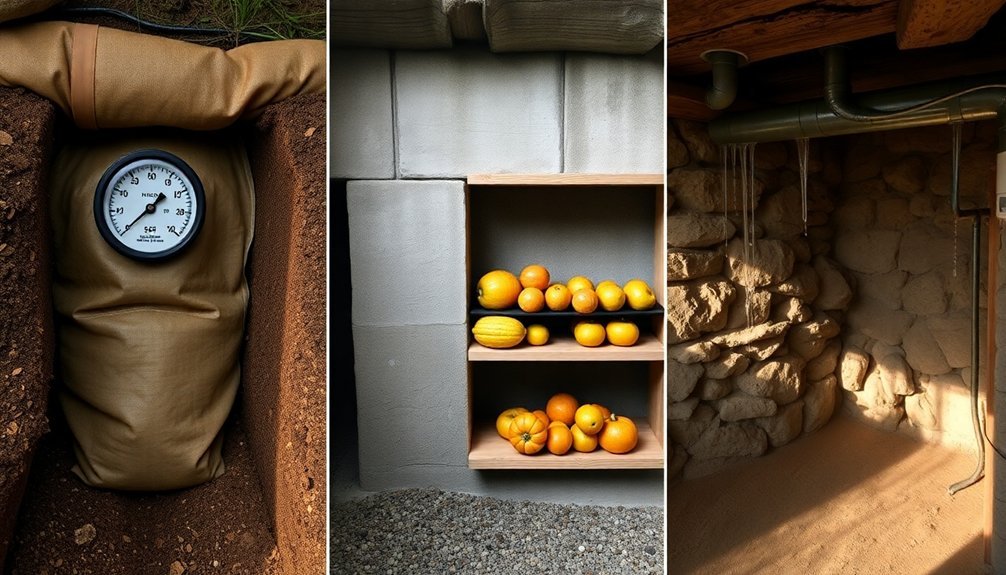
Through careful management of ground temperatures, you'll find that maintaining an effective underground storage system requires attention to multiple factors. You'll need to maintain temperatures between 32° and 40°F for most vegetables while ensuring proper humidity levels of 80-95% for ideal preservation.
Soil depth plays an important role in your storage system's effectiveness. At depths beyond 4.0 meters, you'll achieve stable temperatures between 12°C and 16°C, while shallower depths remain susceptible to external temperature variations.
You can enhance temperature control by installing insulation on walls and ceilings, particularly for above-ground sections that face seasonal fluctuations.
To monitor your storage environment, you'll want to position thermometers throughout the space, remembering that warm air rises to the top of your cellar. For humidity control, you can utilize a dirt floor or place water pans on concrete surfaces.
Don't forget that different foods require varying conditions – while most vegetables thrive in humid environments, squash and onions prefer drier conditions. You can use materials like moist sawdust, sand, or peat moss to maintain proper moisture levels around your stored produce.
Cold Spring Construction Techniques
While constructing an underground storage system, you'll need to implement cold spring techniques to manage thermal stress and structural integrity.
You can choose from several proven methods, including gap cold springing, where you'll create controlled spaces between components during installation, and crimping cold springing, which involves applying radial pressure to pipe fittings.
You'll want to carefully plan your approach by calculating expansion stress and guaranteeing it stays within allowable limits.
When implementing bending cold springing, you'll create slight curvatures in components to handle thermal changes, while shim cold springing lets you adjust positions using precise spacers.
You can also opt for cutting pipes short or long to apply initial loads.
During implementation, you'll need to follow industry standards like ASME B31.3 and remember that cold springing won't reduce overall stress range but will adjust the stress mean.
You'll also want to generate detailed support drawings and communicate load impacts to your civil team.
Always maintain rigorous supervision during construction to guarantee accurate implementation, as proper cold springing will help your storage system achieve thermal shakedown more quickly.
Underground Water Flow Benefits
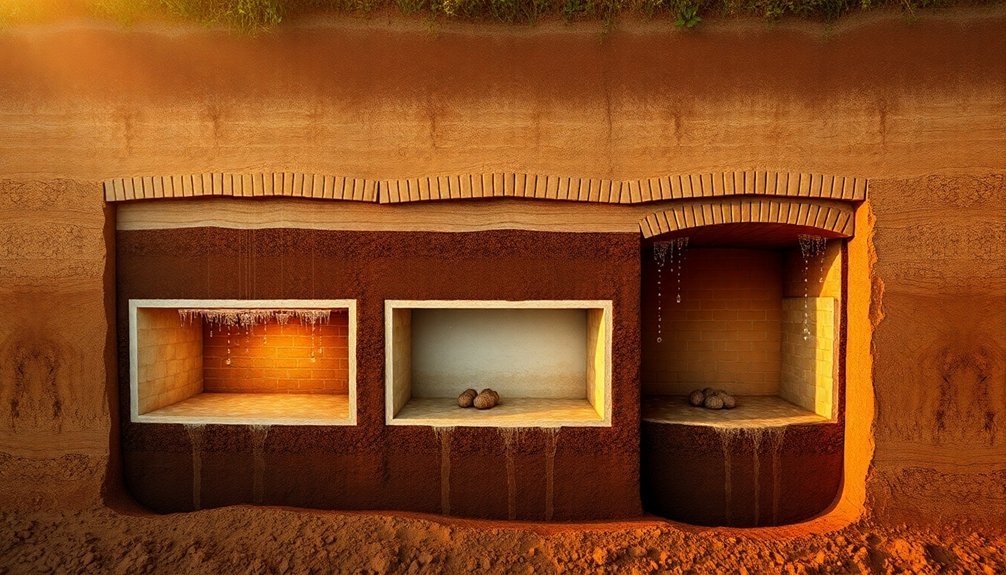
Beyond the structural aspects of cold springing, understanding underground water flow brings significant value to your storage system. When you're selecting an underground storage location, you'll want to take into account how groundwater moves through the soil, as it follows the path of least resistance toward lower elevations. This natural flow pattern can help maintain consistent temperature and humidity levels in your storage area.
You'll benefit from knowing that groundwater typically moves slowly and predictably, which helps regulate the moisture around your storage space. If you've placed your storage system near natural water bodies, you should understand that groundwater eventually feeds into these areas, which could affect the moisture levels in your storage environment.
You'll need to account for seasonal changes, as groundwater recharge occurs at different rates throughout the year. To protect your stored food, you'll want to monitor the direction of groundwater flow using well measurements or professional assessments. This knowledge helps you prevent water infiltration and maintain ideal storage conditions.
You can also use this understanding to implement proper drainage systems that work with, rather than against, natural groundwater patterns.
Frequently Asked Questions
How Long Can Different Types of Cheese Be Stored in Underground Facilities?
You can store your hard and semi-hard cheeses for 6-12 months in underground caves, which maintain a natural 36°F temperature. They'll preserve quality while allowing proper aging and flavor development.
What Natural Pest Control Methods Work Best for Underground Food Storage?
You'll find peppermint oil, bay leaves, and cloves most effective for underground storage pest control. Place cotton balls soaked in peppermint around entry points, scatter bay leaves on shelves, and sprinkle ground cloves near food.
Can Underground Storage Affect the Nutritional Value of Stored Foods?
You'll find that proper underground storage can actually preserve nutrients well, but you must maintain stable temperature and humidity. If conditions aren't controlled, you'll lose nutritional value through moisture or temperature damage.
How Do Electromagnetic Fields Impact Food Preservation in Underground Storage Systems?
You'll find electromagnetic fields reduce ice crystal damage, prevent microbial growth, and maintain food quality in your underground storage. They'll help regulate temperature and preserve nutritional value while minimizing energy consumption during preservation.
What Materials Are Best for Lining Underground Storage Walls Against Groundwater?
You'll get the best groundwater protection by combining DryLok coating with foil-lined insulation panels. Add a polyethylene barrier for extra defense, and seal joints with metal HVAC tape for complete waterproofing.
In Summary
You'll find that underground food storage offers reliable, energy-free preservation when you choose the right method for your needs. Whether you select a traditional root cellar, spring house, or earth-sheltered design, you're tapping into nature's cooling power. Consider your climate, soil type, and available groundwater when deciding. With proper construction and temperature control, you'll enjoy fresh food storage year-round without electricity.

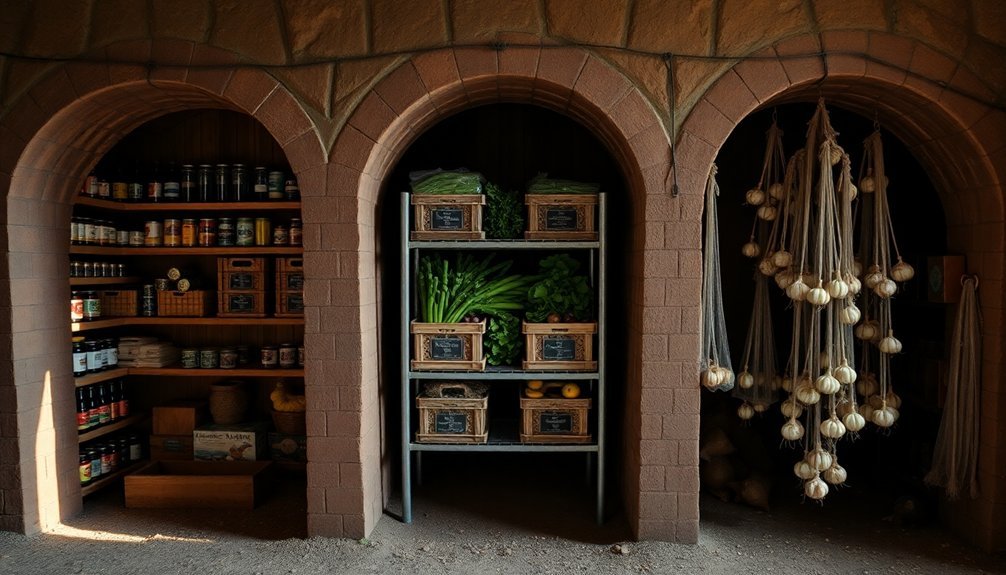



Leave a Reply